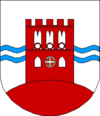Vastseliina
| Vastseliina | |||
|
|||
| State : |
|
||
| Circle : |
|
||
| Coordinates : | 57 ° 44 ′ N , 27 ° 21 ′ E | ||
| Area : | 222.8 km² | ||
| Residents : | 1,937 (2017) | ||
| Population density : | 9 inhabitants per km² | ||
| Time zone : | EET (UTC + 2) | ||
| Community type: | former rural community | ||
| Website : | |||

|
|||
Vastseliina (German: Neuhausen ) is a former rural community in the Estonian district of Võru with an area of 222.8 km². It had 1937 inhabitants (as of January 1, 2017). Vastseliina has been part of the rural municipality of Võru since 2017 .
Vastseliina is located 24 km from Võru . In addition to the main town of Vastseliina, the rural community included the villages Haava, Halla, Heinasoo, Hinniala, Hinsa, Holsta, Illi, Indra, Jeedasküla, Juraski, Kaagu, Kapera, Kerepäälse, Kirikumäe , Kornitsa, Kõo, Kõrve , Käpa, Kündja, Lindlaoruora, , Loosi, Luhte, Mutsu, Mäe-Kõoküla, Möldri, Ortuma, Paloveere, Pari, Perametsa, Plessi, Puutli , Raadi , Saarde, Savioja, Sutte, Tabina, Tallikeste, Tellaste, Tsolli, Vaarkali, Vana-Saaluse, Vana-Vastseliina , Vatsa, Viitka and Voki.
Episcopal Castle
About five kilometers from today's Vastseliina are the ruins of the former bishop's castle of Vastseliina. Its construction began on March 25, 1342 . It was consecrated to the Virgin Mary and was therefore called Frouwenborch . Later the castle was also called Novum castrum , Neuhausen or Schloss Neuhausen . It has been a popular pilgrimage destination since the 14th century. The castle was badly damaged in the Livonian War , but it was rebuilt. It was not until the Northern War in 1702 that the facility was destroyed by Russian troops and has been in ruins ever since.
See also
sons and daughters of the town
- Sirli Hanni (* 1985), biathlete
- Eduard Pütsep (1898–1960), wrestler and trainer
- Endel Sõgel (1922–1998), literary scholar and journalist
- Tagne Tahme (* 1985), biathlete
- Hillar Zahkna (* 1968), biathlete
Web links
- Community website (Estonian, English, Russian)
- Bishop's Castle of Neuhausen (Brick Gothic Heritage)

